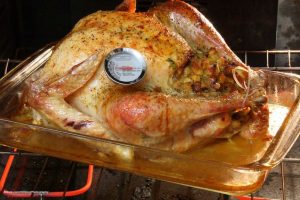The folks at Holiday Food Safety are offering tips for handling your turkey safely for a happy Thanksgiving. The Partnership for Food Safety Education includes the Academy of Nutrition and Dietetics, the Institute of Food Technology, and other organizations.
 Before you buy the turkey, make sure you have room for it in your fridge. Always store the turkey in a large pan so raw juices don’t drip and contaminate other foods. If you buy a frozen turkey, make sure you leave enough time for it to thaw. It takes about 24 hours for every four to five pounds to thaw in the fridge, so by now it’s too late. But you can cook your turkey from the frozen state!
Before you buy the turkey, make sure you have room for it in your fridge. Always store the turkey in a large pan so raw juices don’t drip and contaminate other foods. If you buy a frozen turkey, make sure you leave enough time for it to thaw. It takes about 24 hours for every four to five pounds to thaw in the fridge, so by now it’s too late. But you can cook your turkey from the frozen state!
Always wash your hands with warm water and soap for 20 seconds before and after handling the raw turkey. Never ever defrost the turkey on the countertop. You can thaw the turkey in cold water by submerging it in the water, changing the water every 30 minutes. The turkey will take 30 minutes per pound to thaw. Then cook the turkey immediately; do not refrigerate it and do not refreeze after thawing with this method.
Make sure you choose a safe method for cooking your turkey. Deep frying is very risky. Only stuff the bird just before it goes into the oven. Bake extra stuffing in a greased casserole dish or in the crockpot. All stuffing must be cooked to a minimum temperature of 165°F in the center. Take the temperature of the turkey to make sure it’s fully cooked. Insert a meat thermometer into the thickest part of the thigh, making sure the tip doesn’t touch the bone. It should be 170°F. Let the turkey sit for about 20 minutes, then carve and serve.
For leftovers, always refrigerate perishable foods promptly within 2 hours of cooking. Divide leftovers into small portions and store in shallow containers in the fridge so they can cool down quickly. Reheat cooked leftovers to 165°F as measured by an accurate and reliable food thermometer. And cooked meat should only be kept for 4 days in the fridge; after that time, freeze or discard it.




